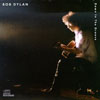BOB DYLAN : DOWN IN THE GROOVE
- Let's Stick Together
- When Did You Leave Heaven?
- Sally Sue Brown
- Death Is Not the End
- Had a Dream About You, Baby
- Ugliest Girl in the World
- silvio
- Ninety Miles an Hour (Down a Dead End Street)
- Shenandoah
- Rank Strangers to Me
Label : Columbia
Released : 1988
Length : 32:04
Review (AllMusic) : If the diffuseness of Knocked Out Loaded was excusable due to its collaborators and various recording sessions, Down in the Groove has less of an excuse, since it's relatively from the same time period, even if it's culled from several different sessions with several different backing band. Nevertheless, the main difference is that, while Knocked Out Loaded was ambitious, this is positively unassuming, at best hoping to capture the mellow roots rock of the Grateful Dead (which it does, on Dylan's irresistible collaborations with Robert Hunter, "Ugliest Girl in the World" and "Silvio"). The rest of the record strolls through covers with amiable ease, whether he's backed by ex-punks or lifetime pros. That may not make for a great record by any stretch, but it's a rather ingratiating one, a little more focused than Knocked Out Loaded and a little looser and funkier than Empire Burlesque. Actually, not as heavy on great moments as either (especially Burlesque), but it's still rather nice in its low-key way.
Review (Wikipedia) : Down in the Groove is singer-songwriter Bob Dylan's 25th studio album, released by Columbia Records in May 1988. A highly collaborative effort, it was Dylan's second consecutive album to receive almost unanimous negative reviews. Released during a period when his recording career was experiencing a slump, sales were disappointing, reaching only #61 in the US and #32 in the UK. "Even by Dylan standards, this album has had a strange, difficult birth," wrote Rolling Stone critic David Fricke. "Its release was delayed for more than half a year, and the track listing was altered at least three times. If the musician credits are any indication, the songs that made the final cut come from half a dozen different recording sessions spread out over six years." Like its predecessor, Knocked Out Loaded, Dylan once again used more collaborators than normal. In a review published in his "Consumer Guide" column, Robert Christgau wrote, "Where Self Portrait was at least weird, splitting the difference between horrible and hilarious, [Dylan is now] forever professional - not a single remake honors or desecrates the original. All he can do to a song is Dylanize it, and thus his Danny Kortchmar band and his Steve Jones-Paul Simonon band are indistinguishable, immersed in that patented and by now meaningless one-take sound." Christgau would later call Down in the Groove a "horrendous product." In his review for Rolling Stone Magazine, Fricke noted that "a highly anticipated - if somewhat unlikely - collaboration with Full Force, the top Brooklyn hip-hop posse, turned out to be an old Infidels outtake, 'Death Is Not the End,' newly garnished with some tasty but rather superfluous Full Force vocal harmonies." 'Death Is Not The End' was covered by Nick Cave in 1996. In 2007, Rolling Stone labeled Down in the Groove as Bob Dylan's worst album. One song, though, a Grateful Dead collaboration titled "Silvio," did experience some success as a single, and Dylan would regularly feature it in his shows. "Silvio" would also be included on 1994's Bob Dylan's Greatest Hits Volume 3 and The Essential Bob Dylan. Soon after Down in the Groove's release, Dylan embarked on a summer tour of North America, presumably in support of Down in the Groove. The first show was on June 7th, 1988, at Concord Pavilion in Concord, California, and it was a dramatic shift from previous tours. In recent years, Dylan had relied on larger ensembles, often staffed with high-profile artists like Mick Taylor, Ian McLagan, The Grateful Dead, and Tom Petty and the Heartbreakers. This time, Dylan organized his concerts around a small, 'garage rock'-type combo, consisting of Dylan, guitarist G.E. Smith (of Saturday Night Live fame), bassist Kenny Aaronson, and drummer Christopher Parker. (There was a notable exception in the early June shows; those concerts featured a second, lead guitarist in Neil Young, whose own career was also in a downturn at the time.) Song selection also became more adventurous, with setlists from different nights offering little resemblance to one another. The concerts would also alternate between full-band, electric sets and smaller, acoustic sets (with Smith providing Dylan's only accompaniment); it was during the acoustic sets that Dylan incorporated an endless variety of traditional cover songs, a marked departure from previous shows that depended heavily on his own compositions. The concerts initially received modest attention, but they would soon receive a generous amount of praise. The tour schedule was also surprising for a man of Dylan's age, as Dylan was spending most of his time on the road. Just as one leg of the tour would end, Dylan would schedule another leg soon after, and this would continue for many years to come. As a result, Dylan's shows are now often referred to as the "Never Ending Tour". Though the supporting personnel would undergo a number of changes for years to come, the basic format begun in the summer of 1988 would continue to this day.
